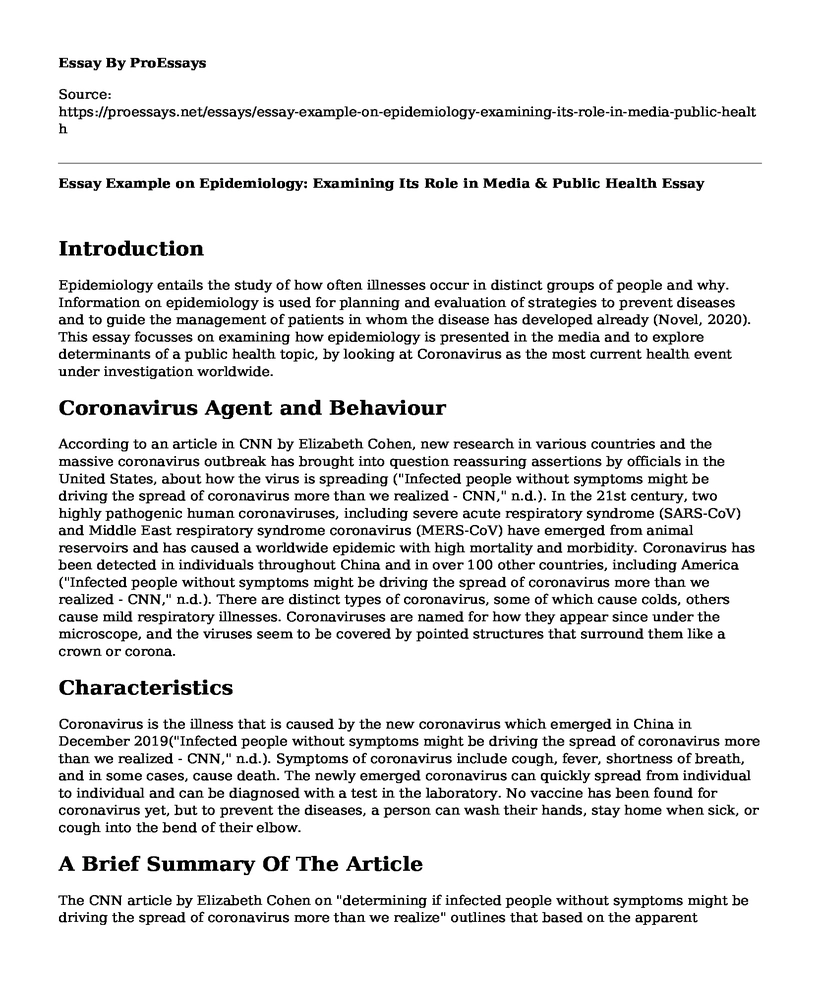Introduction
Epidemiology entails the study of how often illnesses occur in distinct groups of people and why. Information on epidemiology is used for planning and evaluation of strategies to prevent diseases and to guide the management of patients in whom the disease has developed already (Novel, 2020). This essay focusses on examining how epidemiology is presented in the media and to explore determinants of a public health topic, by looking at Coronavirus as the most current health event under investigation worldwide.
Coronavirus Agent and Behaviour
According to an article in CNN by Elizabeth Cohen, new research in various countries and the massive coronavirus outbreak has brought into question reassuring assertions by officials in the United States, about how the virus is spreading ("Infected people without symptoms might be driving the spread of coronavirus more than we realized - CNN," n.d.). In the 21st century, two highly pathogenic human coronaviruses, including severe acute respiratory syndrome (SARS-CoV) and Middle East respiratory syndrome coronavirus (MERS-CoV) have emerged from animal reservoirs and has caused a worldwide epidemic with high mortality and morbidity. Coronavirus has been detected in individuals throughout China and in over 100 other countries, including America ("Infected people without symptoms might be driving the spread of coronavirus more than we realized - CNN," n.d.). There are distinct types of coronavirus, some of which cause colds, others cause mild respiratory illnesses. Coronaviruses are named for how they appear since under the microscope, and the viruses seem to be covered by pointed structures that surround them like a crown or corona.
Characteristics
Coronavirus is the illness that is caused by the new coronavirus which emerged in China in December 2019("Infected people without symptoms might be driving the spread of coronavirus more than we realized - CNN," n.d.). Symptoms of coronavirus include cough, fever, shortness of breath, and in some cases, cause death. The newly emerged coronavirus can quickly spread from individual to individual and can be diagnosed with a test in the laboratory. No vaccine has been found for coronavirus yet, but to prevent the diseases, a person can wash their hands, stay home when sick, or cough into the bend of their elbow.
A Brief Summary Of The Article
The CNN article by Elizabeth Cohen on "determining if infected people without symptoms might be driving the spread of coronavirus more than we realize" outlines that based on the apparent symptoms of coronavirus, most infected individuals can be identified quickly and isolated; hence the outbreak can be controlled ("Infected people without symptoms might be driving the spread of coronavirus more than we realized - CNN," n.d.). Studies have indicated that people with a lack of symptoms are causing a dozen infections. According to the article, the lack of symptoms in some people is not the main reason for the spread of the virus. People under 20 do not seem to show signs, and most studies are trying to find out if this is the group that could be spreading the virus.
Relationship To Public Health
The article by Cohen relates to public health since it outlines coronavirus disease and ways that can be used to protect and improve the health of people and their communities ("Infected people without symptoms might be driving the spread of coronavirus more than we realized - CNN," n.d.). In public health, the goal is the promotion of healthy lifestyles, prevention of injuries, detection of illnesses, and responding to infectious diseases. The article raises a concern about the protection of the health of the entire human population, by wanting to identify if the virus is spread by the people who also do not show any symptoms of infection. The article ends with the public health professional Caroline Colijn, suggesting that presymptomatic transmission is common.
Conclusion
A vital aspect of epidemiology is the measurement of the outcome of a disease related to the population that is at risk. The most talked about event in the world currently is widespread in coronavirus and the lack of a dependable treatment and vaccine. The study of c coronavirus has been conducted, and the population at risk is the most elderly, who are more prone to death. In any epidemiological investigation, the implicit is the notion of the target population where conclusions should be drawn.
References
Infected people without symptoms might be driving the spread of coronavirus more than we realized - CNN. (n.d.), https://edition.cnn.com/2020/03/14/health/coronavirus-asymptomatic-spread/index.html
Novel, C. P. E. R. E. (2020). The epidemiological characteristics of an outbreak of 2019 novel coronavirus diseases (COVID-19) in China. Zhonghua liu xing bing xue za zhi= Zhonghua liuxingbingxue zazhi, 41(2), 145, https://www.ncbi.nlm.nih.gov/pubmed/32064853
Cite this page
Essay Example on Epidemiology: Examining Its Role in Media & Public Health. (2023, Apr 24). Retrieved from https://proessays.net/essays/essay-example-on-epidemiology-examining-its-role-in-media-public-health
If you are the original author of this essay and no longer wish to have it published on the ProEssays website, please click below to request its removal:
- The Influence of Social Media on Teen's Self Esteem Paper Example
- London Campus Refurbishment Project Paper Example
- Why Should a Diabetic Epidemic Be a Serious Concern to Us? - Essay Sample
- Essay Sample on Girl With a Mandolin: Analytic Cubist Painting by Pablo Picasso
- Essay Example on Vaping Devices: Benefits & Risks of Nicotine-Based E-Liquids
- Essay on Predictive Analytics: Revolutionizing Healthcare with Accurate Diagnostics
- Paper on John Wells: From Grandson to Dysfunctional Father-Son Duo







